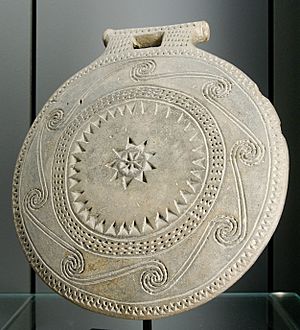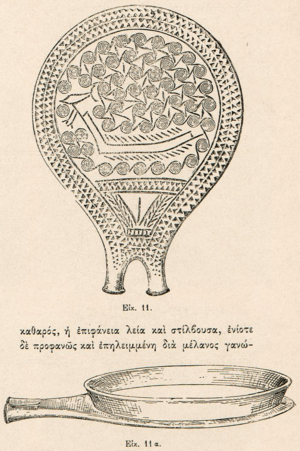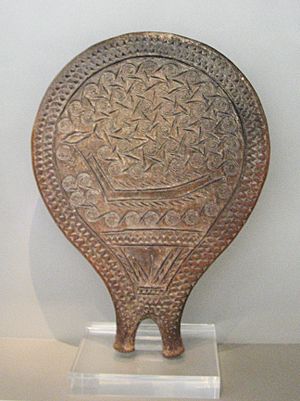Frying pans facts for kids
Cycladic "frying pans" are ancient objects found on the Aegean Islands. They look a bit like modern frying pans, with a flat shape and a handle. Most are made from earthenware (which is a type of clay), but some are made of stone.
These mysterious items come from the Cycladic culture, especially during the Grotta-Pelos and Keros-Syros periods. We don't know exactly what they were used for. Many experts think they were special items, perhaps for important people.
The back of these "frying pans" often has amazing decorations. They were clearly made with great care. About 200 of these objects have been found so far. Most were discovered in ancient graves, but they are still quite rare. Because they are so rare, it's hard for archaeologists to figure out their true purpose.
What They Look Like
Cycladic "frying pans" are usually about 20 to 28 centimeters (8 to 11 inches) across. They have a raised edge and a handle, just like a modern skillet. However, all the cool designs are on the outside rim and on the bottom. These decorations were made by stamping or carving into the clay. The handles come in many different shapes.
Archaeologists have found two main types of these "frying pans":
- Kampos type: These have straight sides with carved lines and spirals. Their handles are rectangular with a crossbar. The main round part often has spirals around a central star.
- Syros type: These have a curved, plain side and a handle with two prongs. The main round part is decorated with stamped circles or spirals. You can often see carved pictures of long boats on them too!
Here are some common patterns you might see on these "frying pans":
- Big stars with circles or bands inside them.
- Rows of triangular patterns, which are very common.
- Circles placed inside each other.
- Patterns that look like wheels.
- Lots of small spirals grouped together.
- Pictures of ships, sometimes with paddles and fish banners.
What Were They Used For?
People have many ideas about what these "frying pans" were used for. Some common theories include:
- Mirrors for scrying (looking into the future).
- Home decorations.
- Drums.
- Objects used in religious ceremonies.
- Pans for making salt.
It's very unlikely they were used for cooking. There are no signs of food or fire on them. Plus, they are usually found in graves, not kitchens. The idea that they were drums also seems unlikely. Drums usually have holes to stretch animal hides over them, and the handles on these objects would make them hard to hold like a drum.
Some people think they were mirrors. Ancient mirrors often had decorated backs. Even though these "frying pans" are made of clay, they could work as mirrors if filled with water or oil. A study in 2009 showed that they work well as mirrors when filled with water or olive oil. Olive oil worked especially well, especially if it was darkened with pigment.
At first, people thought olive oil was too rare and expensive to use for this purpose back then. However, recent discoveries on the island of Keros suggest that olive oil might have been more common than once thought.
It's still a mystery if they had a symbolic or religious purpose. But finding them in graves suggests they might have been important for rituals. Some think they were used to pour out liquids (called libations) as part of ceremonies to help things grow.
Another idea came from Christos Doumas in 1993. He suggested they were used to process sea salt. He thought salt might have been a very valuable item for trade before money was invented. This would explain why they are rare and special, even though salt itself doesn't leave traces for archaeologists to find.
Images for kids
See also
 In Spanish: Sartenes cicládicas para niños
In Spanish: Sartenes cicládicas para niños




